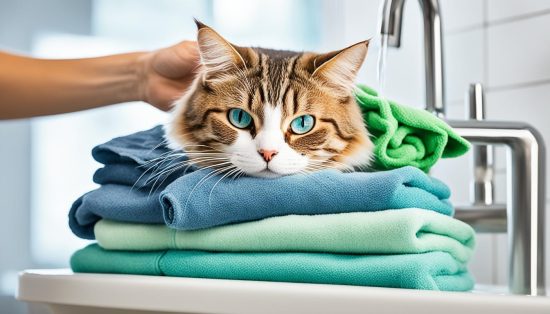How Do Cats Mate? Everything You Need to Know
How do cats mate? Discover the fascinating mating rituals and behaviors of felines during heat cycles, from courtship to conception.
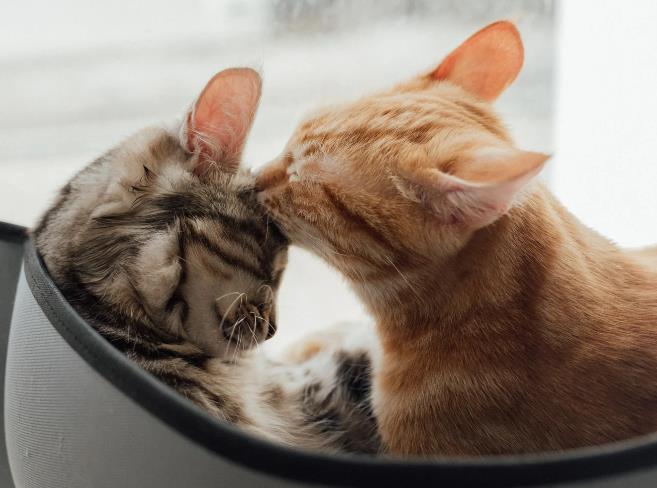
Did you know that the average female cat can give birth to up to 5 litters per year, with each litter containing 2 to 6 kittens? This remarkable reproductive capacity highlights the importance of understanding the intricate mating process in cats. From the female cat’s heat cycle to the mechanics of the act itself, let’s delve into the fascinating world of feline reproduction.
Most pet female cats who are not part of a breeding program should be spayed before puberty. Once they reach puberty, estrous cycles―often called heat cycles―will start. In domestic cats, heat cycles run generally from February through October in the Northern Hemisphere, but they can occur year-round in indoor cats. During heat, the female cat (queen) will be single-minded in her need to mate, will loudly vocalize (call), and lurk near doors, just waiting for the chance to meet up with an intact male cat (tom).
The queen will signal her willingness to mate with a unique posture: chest down, forelegs bent, rear quarters raised with the tail to the side to expose the vulva. The tom will mount the female from the rear, often holding her on the back of the neck with his teeth and insert his penis through her vulva. Intact male cats have barbed penises, and upon withdrawal, the female cat will often scream. It is believed that the barbed penis stimulates ovulation. Female cats are induced ovulators, which means that ovulation does not take place without mating or similar stimulation.
Understanding the Heat Cycle in Female Cats
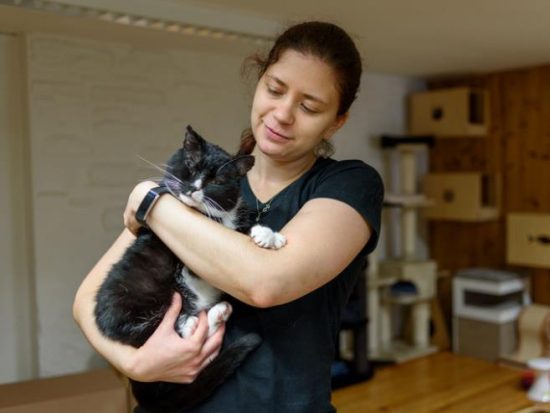
Until a female cat, often referred to as the queen, mates or is spayed, she will experience recurring heat cycles, known as estrus, every two to three weeks. This period of receptivity to mating is linked to the production of estradiol, a type of estrogen, by the ovarian follicles. If the queen does not mate during estrus, her hormonal levels will eventually drop, and the estrous cycle will repeat itself in another two to three weeks.
Signs of Heat in Cats
During a female cat’s heat cycle, or when she is “in heat,” she may exhibit various behaviors, such as increased vocalization, frequent lurking near doors, and adopting a unique posture – chest down, forelegs bent, and rear quarters raised with the tail to the side to expose the vulva. These signs indicate the queen’s willingness to mate and her single-minded focus on finding a suitable tom (male cat) to mate with.
The heat cycle in a cat typically lasts between 3 and 20 days, with an average duration of 5 to 8 days. The interval between the end of one heat and the beginning of the next heat generally ranges from 3 to 14 days, with an average of 10 days.
Hormonal Changes During the Heat Cycle
The cycling queen undergoes specific hormonal changes until she mates. Estrogen is responsible for the queen’s entry into heat, while progesterone is necessary for pregnancy. As the estrogen concentration rises, the queen goes into heat, and when it drops, the heat ends. This rise and fall of estrogen will continue until the queen is mated.
The Mating Process for Cats
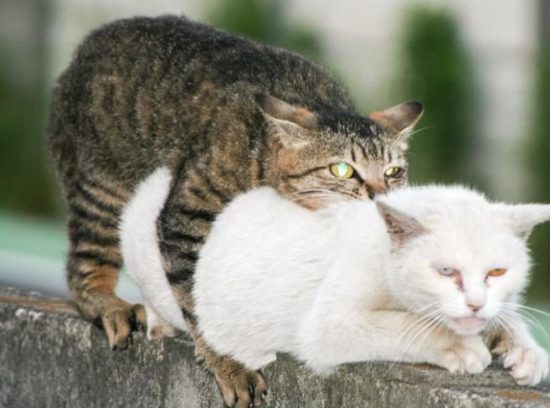
Puberty in a male cat, called a tom cat, sets in at 6 to 8 months of age when he is able to fertilize a female cat. The male’s reproductive life can last 14 years or more. Once the breeding season begins, in general around January or February, the female, called the queen, will go into heat multiple times until the end of the breeding season in October or November.
The Role of the Tom (Male Cat)
The female is able to bear young as early as 7 to 9 months of age and is fertile another 7 to 9 years. The queen will allow mating with various males, and this can result in a variety of different fathers for the same litter. Each kitten has only one father, and kittens within the same litter may all have different fathers.
The Queen’s (Female Cat) Behavior During Mating
When it comes to understanding the mating process, it’s important to know that male cats may bite females during the act of mating. This behavior is common and not an indication of aggression or harm. Observing the cats can also help you determine if they are actively mating, as the female cat may exhibit certain behaviors that signal her receptiveness.
Multiple Matings and Potential for Multiple Fathers
The queen’s ability to mate with multiple partners means that kittens within the same litter can have different fathers. This genetic diversity can be beneficial, but it also highlights the importance of responsible breeding practices to ensure the health and well-being of the feline family.
How Do Cats Mate?
Once the cats get together, the mating process doesn’t last very long – only about half of a minute to about 4 minutes. First the male bites the female’s neck, mounts her and positions himself on top of her. He then thrusts his pelvis into her and finally penetrates her, which usually only lasts about 4 seconds. During this last phase or shortly thereafter, the female will scream and attempt to break free by turning, rolling or striking the male with her paw. Then she will have a so-called “after-reaction” where she’ll roll or thrash and clean herself. This after-reaction may last up to 9 minutes.
The mating process for cats is a fascinating display of their natural instincts. The male cat, known as a tom, initiates the mating by biting the female’s neck to hold her in place. This biting behavior is a normal part of the mating ritual and helps stimulate the female, known as a queen, to accept the male. Once the tom is positioned on top of the queen, he will thrust his pelvis to penetrate her and complete the mating.
During the mating, the queen may vocalize loudly, as the penetration can be somewhat uncomfortable for her. This is likely due to the barbed nature of the tom’s penis, which helps to stimulate ovulation in the female. After the mating is complete, the queen will often exhibit an “after-reaction,” where she will roll, thrash, and groom herself, sometimes for up to 9 minutes. This behavior is thought to be a way for the queen to regain her composure and recover from the mating process.
Understanding the mechanics of how cats mate can provide valuable insights into their reproductive behaviors and help pet owners better care for their feline friends. Whether you have a cat that is unexpectedly pregnant or are considering breeding your own cats, knowledge of the mating process is essential for ensuring the health and well-being of both the mother and her kittens.
Pregnancy in Cats: Signs, Duration, and Diagnosis
Once a female cat, known as a queen, has successfully mated, the next phase in the feline reproductive cycle is pregnancy. Understanding the signs, duration, and methods of diagnosing pregnancy in cats is essential for responsible pet owners and breeders alike. One of the key signs to watch for is whether a female cat exhibits any bleeding after mating, as this can be an indication of a successful mating and the potential for pregnancy.
Detecting Pregnancy in Cats
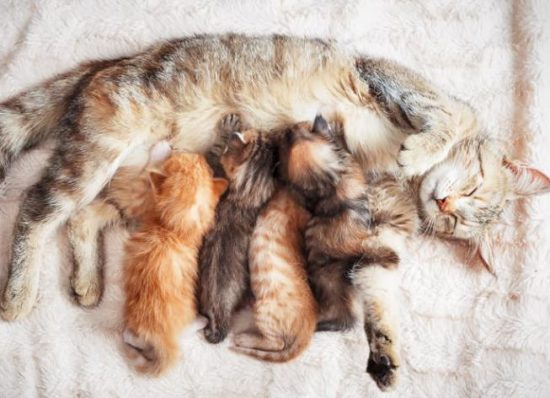
The duration of a cat’s pregnancy typically ranges from 64 to 69 days. The pregnancy can be detected either through physical examination or by using advanced imaging techniques like ultrasound. An experienced veterinarian or breeder can often feel the pregnant uterus in the queen’s abdomen as early as around day 16 of the pregnancy.
Ultrasound for Monitoring Fetal Development
Ultrasound is an invaluable tool for monitoring the development and health of the unborn kittens during a cat’s pregnancy. This non-invasive imaging technique can be performed as early as day 26 of the pregnancy and continued throughout the gestation period. Ultrasound allows veterinarians to assess the number of fetuses, their heartbeat, and any potential abnormalities or complications that may arise. Additionally, some queens will display other signs of pregnancy, such as enlargement and pinkening of the mammary glands, as early as day 18 of the pregnancy.
Caring for a Pregnant Cat
As a pet owner, you’ll want to provide all the things your pregnant cat needs, both for her health and for the health of the unborn kittens. This includes ensuring she has proper nutrition, a comfortable environment, and close monitoring for any potential complications during the gestation period.
Nutritional Requirements
During pregnancy, your cat should either be fed a high-quality kitten food or a diet specifically formulated to meet the nutritional needs of a gestating and lactating feline. These specialized diets are rich in essential nutrients like protein, calcium, and other vitamins and minerals to support the growing kittens and maintain the health of the mother cat.
Providing a Comfortable Environment
Creating a peaceful, low-stress environment for your pregnant cat is crucial. Make sure to give her a quiet, private space to rest and relax, away from any sources of disruption or excitement. Setting up a cozy nesting box early on can serve as both a bed for her during pregnancy and a place for her to give birth and tend to her newborn kittens.
Monitoring for Potential Complications
Throughout the gestation period, it’s important to closely monitor your pregnant cat for any signs of unusual symptoms or potential complications. Pregnant cats may experience issues like premature labor, metabolic changes, or other health problems that require prompt veterinary attention. If you notice anything out of the ordinary, don’t hesitate to consult your veterinarian to ensure the safety and well-being of both the mother and her unborn kittens.
The Birth Process and Newborn Kittens
You may even wake one morning to discover that your pregnant cat has given birth during the night, and is comfortably nursing her kittens. However, you should know how to spot potential problems and what action to take, should she need assistance with the birth process. The first two to three weeks are the most crucial for your mother cat and her newborn kittens. The kittens should be developing rapidly, and the queen will be most at risk for postpartum problems during this time.
Assisting During Labor and Delivery
Keep the queen and her babies in a quiet part of the house; a separate room is ideal, and make sure the room is warm. Getting cold is a big danger to newborn kittens. If the labor seems prolonged or the queen appears to be in distress, it’s best to consult your veterinarian, as is it painful for a cat in heat? They can provide guidance on intervening or monitoring the situation to ensure a safe delivery for both the mother and her kittens.
Caring for Newborn Kittens and the Mother Cat
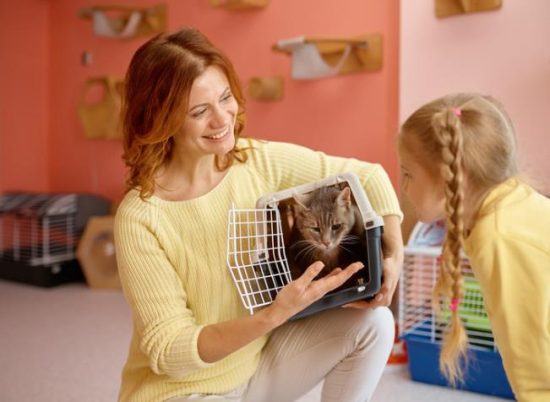
In the days following the birth, keep a close eye on the kittens’ development and the mother cat’s postpartum health. The kittens should be nursing regularly, gaining weight, and exhibiting strong reflexes. Meanwhile, the queen will need extra nutrition and hydration to support milk production and care for her litter. Provide her with a warm, quiet space to rest and recover, and monitor for any signs of complications like is it painful for a cat in heat? Addressing any issues promptly with your veterinarian’s guidance will give the newborn kittens the best start in life.
Responsible Breeding Practices
If you want to breed your male cat, he should come from a healthy litter of good size and be born of a female cat who had no difficulties giving birth or rearing the litter. Like the male, the female should come from a good-sized, healthy litter with a mother that delivered with ease and showed regular heat cycles. How do you know if cats are mating? A good history should be obtained and a complete physical exam performed in order to help detect genetic disorders or illness.
Breeders should be selective in their choice of breeding cats and consider genetic testing to ensure the health and well-being of the kittens. Do cats mate easily? By selecting cats with a strong pedigree and no known genetic issues, breeders can help prevent the transmission of inherited diseases and ensure the kittens are born healthy and robust.
Responsible breeders will also conduct genetic testing on potential breeding cats to screen for any inheritable conditions that could be passed on to the offspring. This helps maintain the overall health and vitality of the breed, while also avoiding the heartbreak and expense of dealing with kittens born with debilitating genetic disorders.
FAQs on How do cats mate
What do female cats do while mating?
During heat, the female cat (queen) will be single-minded in her need to mate, will loudly vocalize (call), and lurk near doors, just waiting for the chance to meet up with an intact male cat (tom). The queen will signal her willingness to mate with a unique posture: chest down, forelegs bent, rear quarters raised with the tail to the side to expose the vulva.
Why do male cats bite females when mating?
The tom will mount the female from the rear, often holding her on the back of the neck with his teeth and insert his penis through her vulva. It is believed that the barbed penis stimulates ovulation.
How do you know if cats are mating?
You can observe the unique mating behaviors, such as the queen’s posture, the tom biting the queen’s neck, and the physical act of mating where the tom mounts the queen and inserts his penis.
Do cats mate easily?
Cats can mate easily, and the female cat will go into heat multiple times until she mates or is spayed. The mating process itself is also relatively quick, lasting only about half a minute to 4 minutes.
Do female cats cry for a mate?
Yes, during heat, the female cat will loudly vocalize (call) as part of her mating behaviors, signaling her willingness to mate.
Do female cats bleed after mating?
There is no evidence that female cats bleed after mating. The female cat may scream or have an “after-reaction” where she rolls, thrashes, or cleans herself, but bleeding is not a typical response.
Do cats feel pain after mating?
There is no clear evidence that cats feel pain after mating. The female cat may have an “after-reaction” where she displays behaviors like rolling, thrashing, or cleaning herself, but this is not necessarily an indication of pain.
Is it painful for a cat in heat?
The heat cycle in cats can be described as a time of increased sexual receptivity and activity, but it is not generally considered to be painful for the cat. However, the constant vocalizations, restlessness, and increased urination associated with heat can be distressing for both the cat and their human companions.
Is heat painful for cats?
No, the heat cycle in cats is not considered to be painful. While the heat cycle can be accompanied by behavioral changes like increased vocalizations and restlessness, the heat itself is not a painful experience for the cat.



